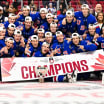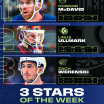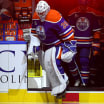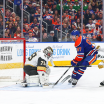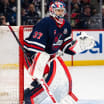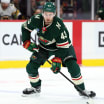For the first time, Hockey Hall of Famer Wayne Gretzky, the all-time leading scorer in NHL history, candidly discusses what the game looks like to him and introduces us to the people who inspired and motivated him: mentors, teammates, rivals, the famous and the lesser known, in his book "99: Stories of the Game," which will be released on Tuesday by Random House.
Gretzky will sign copies of the book at the NHL Powered by Rebook story in Manhattan on Thursday from noon to 1:30 p.m.
Below is an excerpt from the book in which Gretzky discusses the type of stick he used while playing and his admiration for Howie Morenz.
Wayne Gretzky talks sticks in new book
In excerpt from '99: Stories of the Game,' NHL all-time scoring leader discusses evolution of equipment, greatness of Howie Morenz

By
Wayne Gretzky / Special to NHL.com
When I was fourteen or fifteen years old, I'd head down to Canadian National Exhibition Stadium in Toronto, pay a buck, go to a Blue Jays game and then walk around the Hockey Hall of Fame just staring at everything for hours. My friends used to say, "You're going to the Hall of Fame again?"
I'd say, "Yeah."
They'd say, "Same stuff there as last week."
That was the point. I'd look at Howie Morenz's stick and think, "How did he score so much with that stick?" It was so straight and heavy. On some of the old sticks you could even see the nail that joined the blade to the shaft. As a kid, I couldn't get over how different everything looked from the equipment that I was using at the time.
By the time I was playing in the NHL, I was using the best sticks in the world. But today kids look at my sticks and wonder how we ever played the game with lumber like that. Put it this way: you can pick up a goalie stick today and my wooden Titan would've been twice as heavy. The two guys with the stiffest and heaviest sticks in the league in my era were Mike Bossy and me. In fact, he and I used pretty much the same stick for a long time. We might not have had the hardest shots, but we both knew exactly where the puck was going to go. Fans will probably remember the way Bossy and Guy Lafleur would wind up and take a slap shot off the rush at full speed. I used to do the same thing. With a stick that stiff, you needed that windup to get a heavy shot.
With today's whippier sticks, guys can load up quickly and shoot off the back foot, which takes a lot less time. In my experience, the game changed considerably between 1987 and 1997 in that there was less time to get off a slap shot with a full windup. Mark Messier was one of the first guys to shoot off the back foot to catch a goalie napping. I remember Owen Nolan did the same thing in the 1997 All-Star Game-though he wasn't trying to catch Dominik Hasek napping. He actually pointed at the corner he was aiming at and still beat Hasek. But those are big, strong guys. Now everyone is using a whippy stick and using the release to fool goalies into misreading the angle. A guy like Phil Kessel uses his stick like a slingshot. The only time you see a slap shot now pretty much is when a defenseman has time to tee one up from the point. And it's no surprise that the guys with the hardest shots use the stiffest sticks. Shea Weber, Zdeno Chara, and Brent Burns use sticks that a lot of guys couldn't even bend.
In 1989, Jim Easton, who was a good friend of mine, came to me and said, "Wayne, we have this stick for you. It's a product you're going to love. We were able to make the stiffness that you like, but it's only a third of the weight." It was a two-piece stick with an aluminum shaft. I loved it. It was still very stiff-a slap shot seemed to explode off the blade. But it was so light that all the weight was in the blade, so you could feel the puck better.
I thought, "Okay. That sounds good." Because, believe it or not, as a kid I always used a light stick. My dad always said, "You gotta have a light stick."
The other thing I did with my wooden sticks was round the shaft so it was more like a lacrosse stick. Paul Coffey did the same thing. It made it easier to roll your hands down the stick and it was much more comfortable. So Easton made me this stick that was stiff and had a rounded shaft but was much lighter. The first time I used it, I thought, "Wow! Where has this been all my life?"
In L.A. our equipment manager Peter Millar taped my sticks. A lot of people have a tape knob, but I liked a pre-cut knob on top. Every stick was dated. So if you think you've got one of my game sticks, have a look at the end of the stick and there'll be a date on it written with a Sharpie. By then I was using the Easton aluminum two-piece, so Peter would tape up the blade, heat it up, put it in the shaft, and then add the knob and mark the date.
Very few guys used an aluminum two-piece at the time, so when I started using the Easton it kind of changed hockey for a while, because everybody followed. I never used the composite one-piece, but players today swear by it. These days if you showed them an aluminum two-piece, they would look at you and say, "What the heck is that?" And I don't blame them because that's the way I felt back when I was looking at Howie Morenz's sticks when I was a kid.
Obviously, Howie Morenz was before my time. He was before Gordie Howe's time. In fact, when Maurice Richard started tearing up the league, Morenz was the guy fans compared him to. But while I had never seen him play, looking at his stick, I had some sense of what the game would have been like when he played. I could easily imagine how the puck would feel on the blade of a heavy stick like that. The sticks guys used back then were a lot shorter, so I could see that they would have had to play with their hands closer together. You would have the puck on a string with a short stick like that, and a wrist shot would be tough for a goalie to read coming off the blade. But you would really have to keep your head up.
You can see how just looking at those old sticks would fire up a kid's imagination. Peering through the glass of the Hall of Fame, I could see how the game was played. It would have been incredibly tough, but it would also have been an elegant game built around puck control and shrewdly and spontaneously exploiting opportunities. That's how Howie Morenz played the game anyway.
In 1950, the Canadian Press polled sportswriters across the country. They named Morenz the greatest hockey player of the first half of the century. Because so few of us have seen him play, it's not easy to understand what an achievement that is. But put it this way-look at the guys who would top anyone's list of the best players of the secondhalf of the century. Howe, Richard, Hull, Orr, Lafleur, Lemieux. To be the best of the second half of the century, you would have to be better than all of them. Anyone who was the best of the first half is in that league.
Morenz was certainly the NHL's first superstar. Games were sold out wherever he played. For many American fans new to hockey, Morenz was the face of the game. His speed and grace defined hockey for its newest fans, and redefined it for those who loved the game. More than any who had come before him, Morenz showed that while hockey would always be a team game, true greatness could lift people out of their seats.



